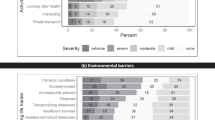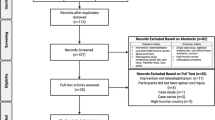Abstract
Introduction
Despite adequate inpatient rehabilitation, a number of spinal cord injury (SCI) individuals suffer from difficulties at home and in their local environments. This is mainly prevalent in low–middle-income countries (LMIC) due to a lack of qualified personal caregivers. This issue could be addressed with the help of telehealth technology, which may be used in LMICs without economic concerns.
Case presentations
A 44-year-old male with C3 AIS C SCI and a 35-year-old female with T12 AIS A SCI were discharged after successful rehabilitation from a tertiary care spinal center. The patients demonstrated gradual loss in their independence, which was evident by monitoring their home activities biweekly for 4 weeks via a combination of telephone calls, live video chat, and WhatsApp. Subsequently after 4 weeks of consistent guidance, pre–post scores after teletherapy were analyzed for the self-care and mobility subcomponents of the self-reported SCIM III.
Discussion
After consistent supervised guidance via telehealth, self-care scores improved in the C3 AIS C case from 3 to 15 and in the T12 AIS A case from 4 to 15, while mobility scores respectively improved from 14 to 27 and 4 to 16. Identification of individual competencies, performance, and capacity in activities of daily living and participation, self-assessment, caregiver training, and home integration contributed toward successful community integration. This case series documents the benefits of using telehealth and home goal planning in the aftercare of SCI individuals, in order to improve quality of life in their local environment.
Similar content being viewed by others
Log in or create a free account to read this content
Gain free access to this article, as well as selected content from this journal and more on nature.com
or
References
Schonherr MC, Groothoff JW, Mulder GA, Eisma WH. Participation and satisfaction after spinal cord injury: results of a vocational and leisure outcome study. Spinal Cord. 2005;43:241–8.
Cox RJ, Amsters DI, Pershouse KJ. The need for a multidisciplinary outreach service for people with spinal cord injury living in the community. Clin Rehabil. 2001;15:600–6.
Tzanos IA, Mitsiokapa E, Megaloikonomos PD, Igoumenou VG, Panagopoulos GN, Papathanasiou J, et al. Social reintegration and quality of life after spinal cord injury: the Greek paradigm. J Biomed. 2016;1:36–43.
Ernst JL, Thomas LM, Hahnstadt WA, Piskule AA. The self-identified long-term care needs of persons with SCI. SCI Psychosoc Process. 1998;1:127–32.
Rawl SM, Easton KL, Kwiatkowski S, Zemen D. Burczyk effectiveness of a nurse-managed follow-up program for rehabilitation patients after discharge. Rehabil Nurs. 1998;23:204–9.
Fekete C, et al. Development and validation of a self-report version of the Spinal Cord Independence Measure (SCIM III). Spinal Cord. 2013;51:40–47.
Silver J, Ljungberg I, Libin A, Groah S. Barriers for individuals with spinal cord injury returning to the community: a preliminary classification. Disabil Health J. 2012. https://doi.org/10.1016/j.dhjo.2012.03.005
Phillips CO, Wright SM, Kern DE, Singa RM, Shepperd S, Rubin HR. Comprehensive discharge planning with postdischarge support for older patients with congestive heart failure: a meta-analysis. JAMA. 2004;291:1358–67. https://doi.org/10.1001/jama.291.11.1358.
David B, Preen Belinda ES, et al. Effects of a multidisciplinary, post-discharge continuance of care intervention on quality of life, discharge satisfaction, and hospital length of stay: a randomized controlled trial. Int J Qual Health Care. 2005;17:43–51.
Shepperd S, McClaran J, Phillips CO, Lannin NA, Clemson LM, McCluskey A, et al. Discharge planning from hospital to home. Cochrane Database Syst Rev. 2010;CD000313.
Carrie HK, Yam, Eliza, Wong LY, et al. Framework and components for effective discharge planning system: a delphi methodology. BMC Health Serv Res. 2012;12:396.
Bjørnshave Noe B, Bjerrum M, Ange S. The beginning of a new life following traumatic spinal cord injury—patient’s experiences one month post-discharge. Int J Phys Med Rehabil. 2015;3:1.
Yang HY, Sanford JA. Home and community environmental features, activity performance, and community participation among older adults with functional limitations. J Aging Res. 2012; 2012.
Carr JJ, Kendall MB, Amsters DI, Pershouse KJ, Kuipers P, Buettner P, et al. Community participation for individuals with spinal cord injury living in Queensland, Australia. Spinal Cord. 2017;55:192–7.
Balbale SN, Lones KA, Hill JN, LaVela SL. Examining participation among persons with spinal cord injuries and disorders using photovoice. Qual Rep. 2017;22:1830–47.
Irgens I, Rekand T, Arora M, Liu N, Marshall R, Biering- Sørensen F, et al. Telehealth for people with spinal cord injury: a narrative review. Spinal Cord. 2018;56:643–55.
Acknowledgements
We would like to thank both the individuals and their caregivers for their participation. The authors would like to give special thanks to Dr H.S. Chhabra and Dr Chitra Kataria for the constant support.
Author information
Authors and Affiliations
Corresponding author
Ethics declarations
Conflict of interest
NT, SAG, and MA declare no conflicts of interest; however, MA is currently developing plans to develop a nonprofit organization, Telerehabilitation International, in which she plans to recruit volunteer physiatrists to provide telehealth to persons with neurologic disabilities.
Additional information
Publisher’s note: Springer Nature remains neutral with regard to jurisdictional claims in published maps and institutional affiliations.
Rights and permissions
About this article
Cite this article
Tyagi, N., Amar Goel, S. & Alexander, M. Improving quality of life after spinal cord injury in India with telehealth. Spinal Cord Ser Cases 5, 70 (2019). https://doi.org/10.1038/s41394-019-0212-x
Received:
Revised:
Accepted:
Published:
DOI: https://doi.org/10.1038/s41394-019-0212-x
This article is cited by
-
Use of telemedicine in the postoperative assessment of proctological patients: a case–control study
Techniques in Coloproctology (2023)
-
Overground robotic training effects on walking and secondary health conditions in individuals with spinal cord injury: systematic review
Journal of NeuroEngineering and Rehabilitation (2022)
-
Telerehabilitation for individuals with spinal cord injury in low-and middle-income countries: a systematic review of the literature
Spinal Cord (2022)
-
Current Approaches in Telehealth and Telerehabilitation for Spinal Cord Injury (TeleSCI)
Current Physical Medicine and Rehabilitation Reports (2022)
-
COVID-19 and spinal cord injury and disease: results of an international survey as the pandemic progresses
Spinal Cord Series and Cases (2021)



